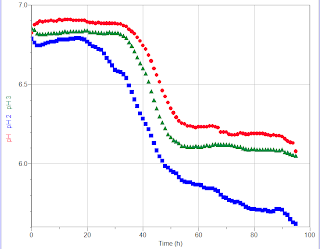Sci-fest competition
For the sci-fest competition
our project is to test:
- The rate at which milk turns acidic
- Which milk container keeps the milk freshest for the longest
- To investigate at what temperature condition milk stays freshest for the longest.
- To compare what type of milk stays freshest for the longest; full fat, low fat and fortified
After brainstorming ideas we
came up with this idea with the help of our teacher. We wanted a project that
would enhance and help solve a problem with something to do with everyday life.
We first looked at the rate at which milk went acidic but decided to expand on
this by resting which milk container kept the milk freshest for longest and
what is the best temperature to store milk at. We also plan on seeing if the
milk went acidic and went off buy the use by date estimated by the
manufacturer.
Before beginning our project
we contacted Kerry Group and Avonmore for information on how they determine the
milks use by date but we have yet to hear back from them. We plan on using data
loggers and pH sensors to record and collect the rate at which the milk turns
acidic in each experiment that we will carry out.
Test 1
To investigate
which milk container keeps milk freshest for the longest.
Aim: To investigate whether plastic,
cardboard or glass has an effect on the shelf life of milk
Apparatus: Data logger, temperature probe, 3 pH
probes, 300mls of fresh milk, tetra pack container, glass bottle, plastic milk
carton
Method:
- Place 100mls of fresh milk into the 3 different containers; tetra pack, glass and plastic in a dark room in order to prevent any light from interfering with the experiment.
- Connect 3 pH probes to a data logger and place one in each container.
- Before the data logger begins to take readings, find the temperature of the room they will be stored in using a temperature probe.
- Set the data logger to measure the pH of the milk every hour for 120 hours.
- Once the data logger is finished recording the results, connect the data logger up to the computer and upload the graph onto the computer.
pH 1 = Cardboard Container
pH 2 = Glass Container
pH 3 = plastic Container
Test 2
pH 2 = Glass Container
pH 3 = plastic Container
Test 2
To investigate at what temperature
milk stays freshest for the longest
Aim: To investigate if milk stays fresher
at room temperature, in a fridge or in a hot surrounding.
Apparatus: 3 Data loggers, 3 pH probes, 3 temperature
probe, 300mls od fresh milk, 3 plastic milk cartons, small oven, a fridge.
Method:
- Place 100mls of fresh milk into 3 plastic milk cartons.
- Measure and record the temperature of the fridge, the store room and the oven.
- Place a pH probe into each container and connect them to 3 separate data loggers and plug them into a socket to charge.
- Place one plastic milk container in the fridge, one plastic milk container in a store room and one plastic milk container in an oven.
- Set each data logger to record the pH of each carton of milk every hour for 96 hours.
- Once the data loggers are finished recording the results, connect them up to the computer and upload the graph onto the computer.
pH 1 = Oven (40 degrees)
pH 2 = Fridge (4.6 degrees)
pH 3 = Room Temperature (21.5 degrees)
Test 3
To investigate which
type of milk stays fresher for longer
Aim: To investigate what type of milk goes
off the fastest; full fat milk, low fat milk, fortified milk.
Apparatus: 100mls Full fat milk, 100mls low fat milk,
100mls fortified milk, 3 glass beakers, data logger, temperature probe, 3 pH
probes.
Method:
- Pour 100mls of each type of milk into 3 different glass containers.
- Label each glass container to avoid confusion.
- Take the temperature of the room that the milk will be stored in.
- Connect the 3 pH probes to the data logger and then place one probe into each labelled glass container of milk.
- Set the data logger to record every hour for 96hrs to find out which type of milk has the longest shelf life.
- Once the data logger is finished recording the results, connect the data logger up to the computer and upload the graph onto the computer.
pH 1 = Full fat milk
pH 2 = Low fat Milk
pH 3 = Fortified Milk
Check out the full Sci-fest website here



No comments:
Post a Comment